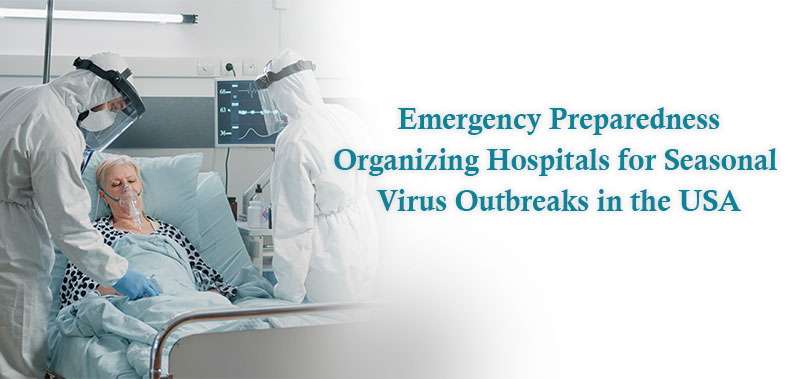
Emergency Preparedness: Organizing Hospitals for Seasonal Virus Outbreaks in the USA
Outbreaks of infectious disease, disasters, and conflict have reminded the world of the reality that it is still prone to health emergencies with global consequences. Significant gaps still exist in the ability of many countries to address all hazards, health emergencies, and disaster risks. WHO has played an increasingly operational role in the past few years. Ongoing conflict and inadequate health systems mean that many countries cannot provide the most basic health, nutrition, and social services. It is in these vulnerable settings where most deaths among children under five occur, as well as the highest rates of maternal mortality, unintended pregnancy, sexual and gender-based violence, malnutrition, mental disorders, underimmunisation, and infectious disease outbreaks. Conflict, climate change, population growth, and movements are changing the context in which we operate. An estimated 1.4 billion people live in fragile, conflict-affected, and vulnerable settings. Eighty per cent of people are affected by health emergencies, and 70% of cases due to epidemic-prone diseases occur in conflict-affected settings. Meanwhile, a record number of people around the world, more than 69 million, have been forcibly displaced, many of whom are cut off from accessing basic health services.
In the event of a seasonal virus outbreak, hospitals have a big role to play by being ready to protect public health within a very short period. Effective emergency preparedness includes proactive planning, resource distribution, and coordination among various departments to ensure optimal patient care and minimise the spread of the virus.
Understanding the Implication of HMPV
Human Metapneumovirus (HMPV) has been in the spotlight as it is responsible for severe respiratory infections among children, the elderly, and immunocompromised patients. Seasonal surges of HMPV force hospitals to be on their toes and ready to take on a large number of patients presenting with respiratory symptoms. In contrast to other seasonal viruses, HMPV usually compels hospitals to utilise high-end diagnostic equipment and isolation techniques to avoid cross-contamination.
A centralised command centre will be necessary to manage the command and control at the hospital's level. Ideally, this must comprise a command centre that allows departmental, local health authorities and government departments' communication toward planning. It needs to monitor patients admitted, occupancy of beds, as well as real-time cases of HMPV spreading. Quick decisions on resource allocation and protocol adjustments can make a significant difference in managing patient care effectively.
Establish Triage
Hospitals during a virus outbreak, such as HMPV, receive a rush of patients. The triage system assists in giving proper care with severity and the available resources. Patients suspected of HMPV should be put in different sections so that they are not transmitted to others. Furthermore, education of staff in terms of swift identification of HMPV symptoms such as coughing, fever, and difficulty breathing can help elevate the care in the event that it is required. There should be an increase in infection control measures within the hospitals to save both patients and healthcare workers. This can be achieved by ensuring the provision of PPE like masks, gloves, and gowns in HMPV wards.
During an HMPV outbreak, hospitals must optimise their capacity by converting noncritical areas into temporary care units. They can partner with local facilities to share the patient loads, and telemedicine can be employed for noncritical consultations that will significantly reduce hospital visits and create space for patients with severe respiratory symptoms. Strengthening emergency capacities helps public health systems handle the first shocks of emergencies as well as subsequent recovery. This work is performed over the long term and is supported by enhancing operational readiness, which identifies risks with the highest likelihood so that targeted responses can be prepared.
Frontline workers are the backbones of any emergency response. Conducting periodic training exercises in the handling of HMPV outbreaks improves preparedness. Providing psychological support and counselling against stress and burnout, along with ensuring that workloads are evenly distributed, maintains morale and efficiency among the staff. Cases should be reported to the CDC for monitoring and guidelines in case of an HMPV outbreak. Coordinated responses from public health agencies will be ensured through collaboration. Health facilities and agencies will remain prepared through participation in a state-level emergency response plan under the Department of Health and Human Services policy.
During HMPV outbreaks, advanced technologies can make the response much more efficient. Predictive analytics can predict when patients will arrive and needed resources, and EHRs ensure that there is a seamless flow of information between departments. With tools like GIS, monitoring trends of virus spread will help in developing containment strategies. Once the outbreak of HMPV has subsided, hospitals should analyse their response for the next event. This involves debriefing staff to understand what worked and what didn't, revising emergency plans based on the lessons learned, and replenishing depleted supplies in order to get back to normal operations.
Conclusion
Emergency preparedness to anticipate a seasonal outbreak of the virus, particularly HMPV, requires hospitals to respond with speed, flexibility, and alertness. Through these strategies, healthcare delivery institutions in the USA will be better able to respond to the community's needs and minimise the impact of the virus with the strength to rebound against future difficulties. Proactive planning is not only a necessity but also a responsibility for health and safety.




